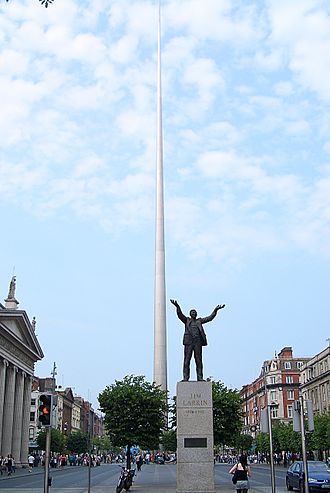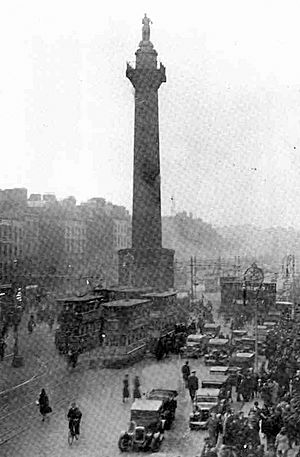Spire of Dublin facts for kids
Quick facts for kids Spire of DublinMonument of Light |
|
|---|---|

Seen from O'Connell Street
|
|
| General information | |
| Type | Monument, sculpture |
| Location | Dublin, Ireland |
| Coordinates | 53°20′59″N 6°15′37″W / 53.34972°N 6.26028°W |
| Construction started | 2002 |
| Completed | 21 January 2003 |
| Cost | €4,000,000 |
| Client | Dublin City Council |
| Height | |
| Antenna spire | 120 m (393.7 ft) |
| Design and construction | |
| Architect | Ian Ritchie Architects |
| Engineer | Arup |
The Spire of Dublin is a very tall, shiny monument in Dublin, Ireland. It is also called the Monument of Light. This amazing structure is made of stainless steel and looks like a giant pin. It stands 120 metres (390 ft) high on O'Connell Street. This spot used to be home to an old monument called Nelson's Pillar.
Contents
What is the Spire of Dublin?
The Spire was created by Ian Ritchie Architects. They wanted it to look "simple, elegant, and dynamic." The building work was done by SIAC-Radley JV. Radley Engineering, from Dungarvan, made the parts. SIAC Construction Ltd and GDW Engineering Ltd put them together.
How was the Spire built?
The first part of the Spire was put up on December 18, 2002. It took some time to get permission to build it. There were also rules about protecting the environment. The Spire is made of eight hollow sections of stainless steel. The longest section is 20 m (66 ft) long. All sections were put in place by January 21, 2003.
The Spire is shaped like a long cone. It is 3 m (9.8 ft) wide at the bottom. It gets much narrower at the top, only 15 cm (5.9 in) wide. Engineers from Arup added special parts inside. These are called tuned mass dampers. They help stop the Spire from swaying too much in the wind. The steel was also treated to make it reflect light in a special way.
What designs are on the Spire?
The bottom part of the Spire has a unique pattern. This design is based on two things. One is a rock sample taken from the ground where the Spire stands. The other is the shape of DNA. This pattern was put onto the steel using a special method. They used rubber stencils and blasted tiny beads at the steel.
The design covers the lower 10 m (33 ft) of the Spire. The architects first made a 3D model of the pattern. Then, they turned it into a 2D drawing for the builders.
How does the Spire light up?
When it gets dark, the bottom of the Spire lights up. The top 10 m (33 ft) also glows. This light comes from 11,884 tiny holes. Each hole has a light-emitting diode, or LED, shining through it.
Why was the Spire built?

The Spire was planned as part of a big project. This project aimed to make O'Connell Street look better. In the past, the street had become less attractive. There were many fast-food places and shops with cheap plastic fronts. Some areas were also empty and run-down.
A major event in 1966 also led to changes. The old Nelson's Pillar monument was destroyed by a bomb. For a while, another monument called Anna Livia stood in its place. This was for Dublin's 1,000-year celebration in 1988.
How did O'Connell Street change?
In the 1990s, plans began to improve the street. Many old trees in the middle of the street were cut down. They had grown too big and blocked views. This was a bit controversial because the trees were very old. Statues were cleaned, and some were moved to new spots. Shop owners had to change their plastic signs to nicer designs.
Traffic was also changed to make the street better for people walking. The main part of this big plan was to build a new monument. This new monument would replace Nelson's Pillar. The Spire of Dublin was chosen after a big international competition. The Anna Livia monument was moved in 2001 to make room for the Spire.
Awards for the Spire
The Spire of Dublin has been recognized for its design and construction. It was nominated for several awards:
- In 2003, it was a finalist for the British Construction Industry International Award.
- In 2004, it was shortlisted for the RIBA National Award and the Stirling Prize.
- In 2005, it was on the list for the Mies Van der Rohe Prize.
Gallery
Images for kids
See also
 In Spanish: Spire de Dublín para niños
In Spanish: Spire de Dublín para niños








